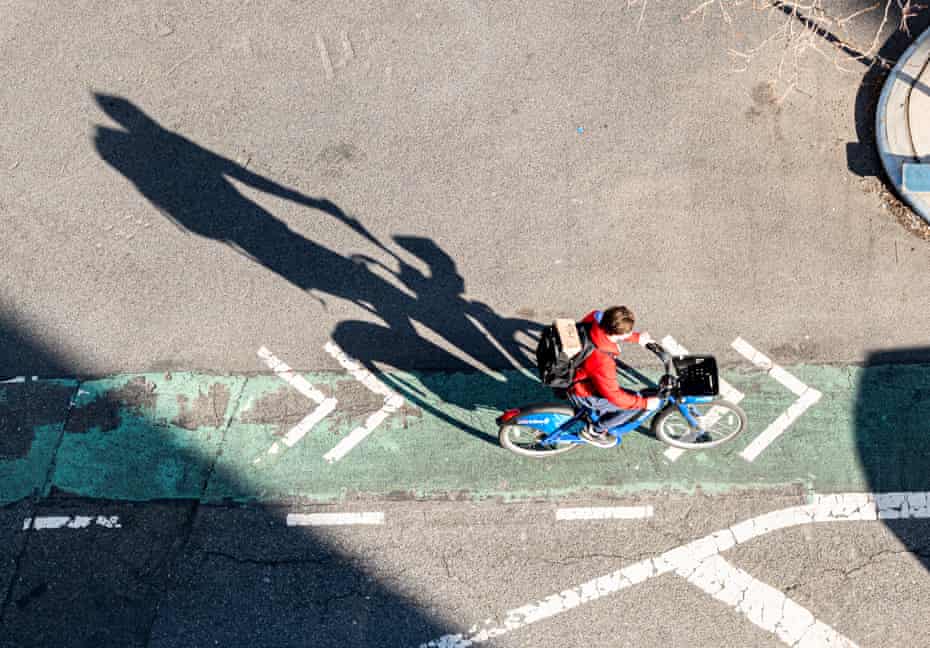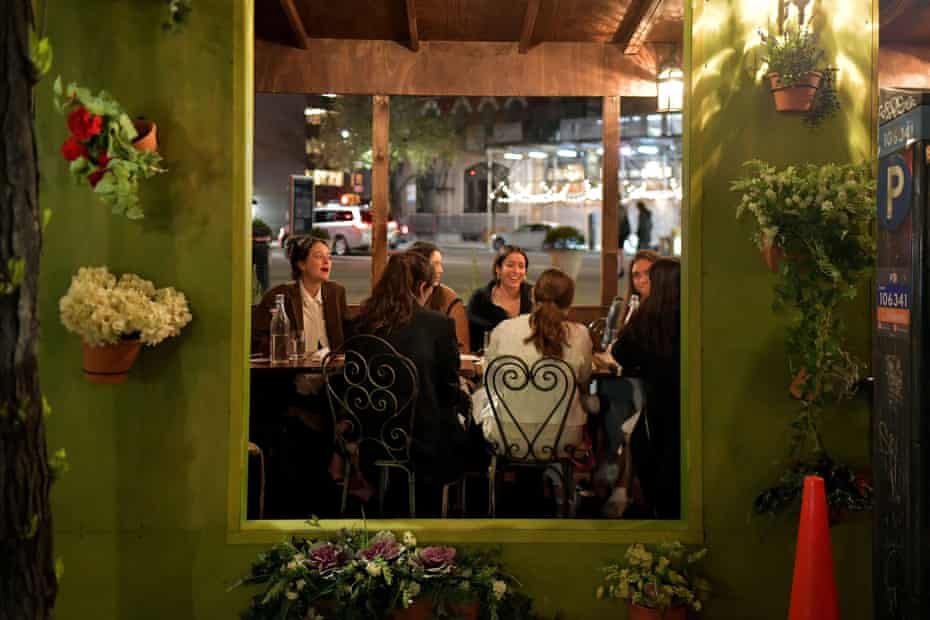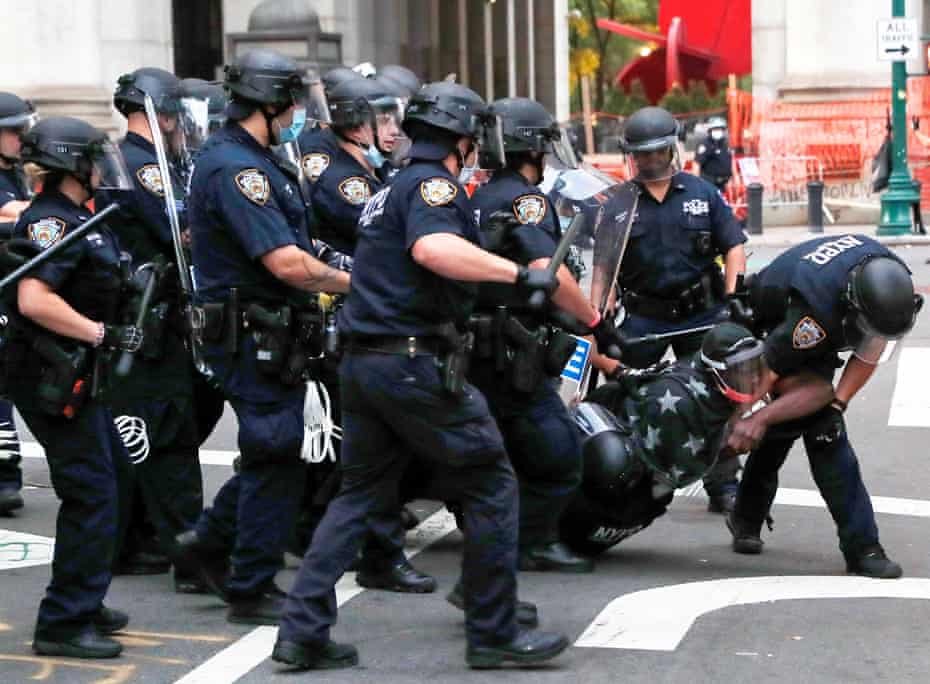Of any city in the US, perhaps none has been so marked by the pandemic as New York.
Early last year, the city became the Covid capital of the world, seeing 18,679 deaths in three months. Many from the city’s wealthiest zip codes moved to more spacious places, while those in low-income zip codes bore the brunt of the virus’s health and economic impacts.
Now, despite the alarm raised by anecdotes that the city was dead forever, the numbers show New York appears to be on its way back.
Covid cases, along with hospitalizations and death, have plummeted in the city as nearly half of the population has received at least one dose of the vaccine. Home sales have increased while the number of available apartments has decreased. Tourists are slowly coming back for selfies on the Brooklyn Bridge, and beloved restaurants and bars are reopening after months of closure. Though Broadway shows will not be coming back until the fall, tickets for Hamilton’s shows in September are already sold out.
Some New Yorkers see the city’s reopening not only as a breath of relief, but also as the perfect time to kick off progressive changes. The Guardian spoke to advocates from four policy areas – housing, education, transportation and criminal justice – who believe the city can utilize changes brought on the pandemic to make the it more equitable, and fairer.
They envision a city with more affordable housing, stronger public schools, more accountability in the criminal justice system and less space for cars on the city streets. While the changes may seem radical, advocates argue the city has already seen what many could not imagine during the pandemic. Plus, with a $5.6bn boost in federal stimulus aid, the city has resources it needs to produce change.

“Historically, we try to recover to [what was] the same, we try to just get back to what we were before, and this is a real moment for us to say we don’t want to just be February 2020, we want to be something very different,” said Barika Williams, executive director of the Association for the Neighborhood and Housing Development (ANHD), a coalition of housing organizations in New York. “Rewinding is not the goal.”
Preventing a mass eviction crisis
Headlines declaring the city “dead” have mostly centered on the flight of the wealthy, which has led to a decrease in housing and rent prices in certain parts of the city.
But the decrease in market prices has not aided the city’s most vulnerable, many of whom are at risk of eviction. More than 51,000 eviction notices have been filed in New York City since March last year, according to Princeton’s Eviction Lab, but evictions have largely been stalled because of the state’s eviction moratorium, which extends until the end of August.
Worries of a massive eviction crisis once the moratorium ends are prominent. The state’s most recent budget includes a $2.4bn program dedicated to giving low-income New Yorkers assistance in paying back rent, but advocates are worried it will be inaccessible. Over 57,000 applicants were denied from a similar $100m program the state enacted in July to help renters, with many saying the criteria were too hard to meet.
“For these families that couldn’t make rent during the pandemic, there is going to be nowhere for them to go,” said Jonathan Westin, the head of New York Communities for Change, which organizes low-wage workers and tenants.
The impending eviction crisis has made creating more affordable housing imperative. More than 70,000 people experienced homelessness in the city in 2019, a number that advocates say attests to the shortage of affordable housing. At least a quarter of New Yorkers earning under $50,000 are rent burdened, meaning 50% of their household income goes toward rent, with the percentage who are rent burdened being even higher for those in the lowest-income brackets.
A coalition of advocates, developers and tenant organizers released a $4bn proposed plan in December that asks the city to rethink bureaucratic hurdles that make building affordable housing difficult.
Housing advocates point to the upcoming rezoning of SoHo and NoHo, two pricey and trendy neighborhoods in Manhattan, as a hopeful sign that the city will consider opening up other wealthier areas of the city to housing development.
In January, New York’s governor, Andrew Cuomo, said that the state could aid the creation of housing converted from distressed hotels or office spaces, which account for more than 79m sq feet of vacant space in Manhattan alone.
The idea of using vacant spaces for housing excites advocates like Williams of ANHD, who pointed to the successful conversion of vacant office spaces in the financial district into housing after companies fled the area after 9/11.
“We have entire companies … who are like, ‘We are never going back to any in-person office,’” said Williams. “That’s an opportunity for us to really think about commercial-residential conversion.”
Increasing resources for schools
When New York shut down its public schools in March last year, 1.1 million students in the country’s largest school district abruptly transitioned to remote learning. Though schools welcomed about half of the student population back for in-person learning in November, the school district – like many across the country – is grappling with the year of learning that was lost for students who struggled with online instruction.
With an influx of state and federal aid, the budgets of city schools are expected to get a $600m boost that will especially help the neediest students. The money means avoiding teacher layoffs, increasing hiring for staff positions like school librarian, nurses and social workers and repairing ageing school buildings.
The next challenge is ensuring that the money gets spent wisely and fairly.
“We need to get this right. We’re probably never going to see this amount of money ever again,” said Maria Bautista, campaigns director for the Alliance for Quality Education.
Advocates like Bautista see the district’s new funding as an opportunity to prioritize support for the district’s most vulnerable students. More than 111,000 students in the school district are in families that are experiencing homelessness or housing insecurity, and city data released in October showed that 77,000 students in public housing and shelters did not have adequate wifi or technology for remote learning.
The city recently announced initiatives that advocates have long asked for, including increasing low-cost broadband and opening up summer school to all students, but the city still has many well-established issues to address, like diversifying specialized schools, offering curriculums centered around critical race theory and decreasing the presence of police officers in schools.
“Covid unsurfaced the amount and levels of inequity that are seeped into our education system, but before then, there was a racism pandemic. Our schools have never been addressed in the way that they need to be,” Bautista said.
Transforming the city streets
The most noticeable change to New York City can easily be seen on its streets. Restaurant tables now line many of the city’s roads, and a handful of streets have been completely blocked off to cars to give pedestrians and cyclists more open space.
Advocates who have long fought for fewer cars in the city say the difference has been noticeable and previews a radical new future.
“The immediate impacts have been clear, whether it’s residents who can hear birds outside of their window or a kid can cross a street without fear,” said Danny Harris, executive director of Transportation Alternatives. “Schools, restaurants and retail can now see their future as being tied to having more space, which is out on the street.”

The fight for fewer cars predates the pandemic, when advocates successfully pushed for changes like more protected bike and bus lanes, and congestion pricing in midtown Manhattan. Transportation Alternatives and other advocate groups say the city should go even further.
A fresh proposal calls on the city to dedicate 25% of its street to pedestrians, cyclists and public transit by 2025. The plan proposes 500 miles of protected bus-only lanes, 500 miles of protected bike lanes, and 1,000 miles of pedestrian and cyclist lanes that are closed off to cars.
“Think about the experience in New York moving around: honking, traffic, congestion, traffic violence … The notion to go back to that, with even more cars, will paralyze the city,” Harris said. “Our city cannot afford to be drowning in car traffic.”
Rethinking policing
Calls for police reform have gained traction in New York, as they have in many cities across the country, since the police killing of George Floyd last May.
In response to calls for reform, the city council passed a bill ending qualified immunity for police officers, which prevented people from suing individual police officers in civil court for violating their constitutional rights.
But other changes the city has made have come under criticism. Mayor Bill de Blasio has been specifically criticized for putting out a plan in March – which included a new reconciliation process and having the New York police department (NYPD) participate in an independent review – that critics say falls short of including any substantive changes.

“[De Blasio] is unwilling to clash with the police department. He is unwilling to say, ‘We’re actually going to make real change.’ He ultimately defers to them and is beholden to what the police department wants,” said Alice Fontier, managing director of Neighborhood Defender Service of Harlem, a non-profit public defender office.
Complicating calls for reform is the uptick in crime that has been seen in the city, as with many places across the country, which experts say is the product of rising social and economic anxiety during the pandemic. More than 500 people have been shot in the city in 2021 so far – the highest number seen at this point in the year in a decade.
City and state officials have largely pointed fingers at each other over rising crime. Progressives say the city needs to address the economic anxieties to lower the crime rate, while the city’s conservative voices have said boosting the NYPD is the answer.
Progressive advocates, most of whom have called for deep cuts to the NYPD’s $10bn budget, have all but given up on the current mayor to listen to their demands. Instead, attention has turned to the upcoming mayoral race, where policing has become a key issue.
New mayor, new city
The city is slated to get a new mayor at the beginning of 2022. The most important race in the election will be the Democratic primary, which will take place on 22 June.
For the first time in the city’s history, voters will be able to rank their top five candidates in the race, which currently has a dizzying 22-contender field.
Among the more moderate candidates in the race is Andrew Yang, best known for his presidential campaign in 2020. He has been deemed the “fun” candidate, who hopes to draw businesses, tourists and wealthier residents back to New York. Eric Adams, a former police officer and Brooklyn borough president, is running on a public safety platform that entails increasing police presence and bringing back a controversial plainclothes NYPD anti-crime unit.
Scott Stringer, currently the city’s comptroller, is seen as one of the more progressive candidates in the field, pushing for a slate of policies like defunding NYPD by $1.1bn and giving $1bn to small businesses. Stringer’s campaign has been derailed by a sexual harassment allegation, which he denies. Dianne Morales, a former non-profit executive, has put out the most progressive slate of policies among the race’s top contenders, including halving the NYPD’s budget, but has polled behind the race’s more moderate candidates.
Advocates across the four issues have emphasized that their visions of a new New York largely depend on who takes over city hall in 2022.
“Without a mayor who’s willing to push for anything, change is never going to happen,” Frontier said.
This content first appear on the guardian
